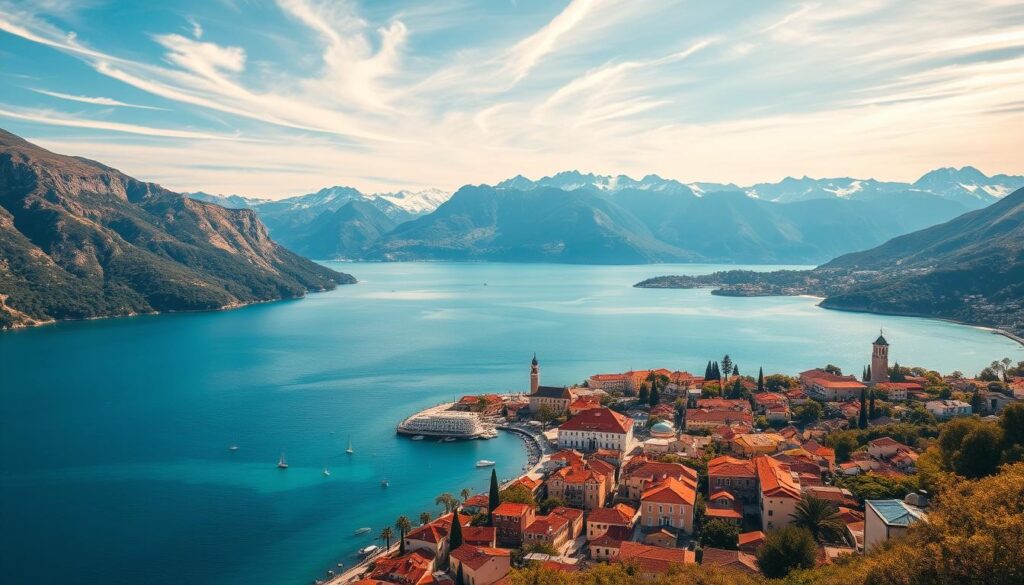Imagine a country where ancient walled cities meet rugged mountains and breathtaking coastal vistas. Montenegro is a traveler’s paradise. It offers a mix of history, culture, and outdoor activities for everyone so gear up now to discover Top 10 Places to Visit in Montenegro.
With its diverse landscapes, you can explore medieval towns, enjoy water sports on pristine lakes, or hike through national parks. Whether you’re looking for relaxation or adventure, Montenegro’s unique blend of Mediterranean charm and Balkan hospitality makes it an ideal destination.
Key Takeaways
- Explore ancient walled cities and medieval towns.
- Enjoy outdoor activities like hiking and water sports.
- Experience the blend of Mediterranean and Balkan cultures.
- Relax on pristine beaches and lakes.
- Discover Montenegro’s rich history and heritage.
Discovering Top 10 Places to Visit in Montenegro: The Adriatic’s Hidden Gem
Montenegro is a hidden treasure of the Adriatic. It offers a mix of ancient towns and untouched natural beauty. You can dive into a rich history, diverse landscapes, and unique culture. This makes Montenegro a captivating place to visit.
A Brief History of Montenegro
Montenegro’s history is a blend of many cultures. The Romans, Byzantines, and Ottomans all left their mark. You can see this in the country’s architecture, food, and traditions.
Key historical events include:
- The establishment of the medieval state of Duklja in the 10th century.
- The reign of the Petrović dynasty, who played a significant role in Montenegro’s modern history.
- The country’s struggle for independence, culminating in its recognition in 1878.
Geography and Climate
Montenegro’s landscape is varied, with mountains, forests, and a coastline along the Adriatic Sea. The country is divided into three main areas: the coast, the central plain, and the mountains. You can enjoy different climates, from Mediterranean to Alpine, all year round.
The diverse geography supports a wide range of flora and fauna, making it a haven for nature lovers.
What Makes Montenegro Famous
Montenegro is famous for its stunning natural beauty. Places like the Bay of Kotor, Durmitor National Park, and Budva’s old town are breathtaking. The country’s mix of cultures, landscapes, and history draws many visitors.
Some of the top attractions include:
- The walled city of Kotor, a UNESCO World Heritage Site.
- The stunning island of Sveti Stefan, known for its picturesque village.
- The beautiful beaches of Budva, a favorite among tourists.
When to Visit Montenegro: Seasonal Guide
The best time to visit Montenegro depends on what you want. You can enjoy the lively summer or the peaceful winter.
Peak Season (June-August)
Summer is the busiest time in Montenegro. The weather is warm, and the days are long. It’s great for seeing the beautiful coast and islands.
Key Highlights:
- Warm weather with average highs around 28°C (82°F)
- Ideal for swimming, sailing, and other water activities
- Bustling atmosphere with many cultural events and festivals
Shoulder Seasons (April-May, September-October)
The shoulder seasons are perfect for those who like a calm vibe. The weather is nice, and there are fewer people around.
Benefits:
- Mild temperatures, ranging from 15°C to 25°C (59°F to 77°F)
- Lower prices for accommodations and tourist services
- Perfect for hiking, biking, and exploring national parks
Off-Season (November-March)
The off-season is cooler, but Montenegro still has lots to offer. You can ski, explore towns, or relax in spas.
Notable Activities:
- Skiing and snowboarding in Durmitor National Park
- Exploring historic towns and cities without the crowds
- Relaxing in thermal spas and wellness centers
Here’s a summary of the average temperatures and tourist seasons in Montenegro:
| Season | Months | Average Temperature | Tourist Season |
|---|---|---|---|
| Peak Season | June-August | 28°C (82°F) | Bustling |
| Shoulder Season | April-May, September-October | 15°C-25°C (59°F-77°F) | Moderate |
| Off-Season | November-March | 5°C-15°C (41°F-59°F) | Quiet |
Kotor: Medieval Charm in a Breathtaking Bay
Step into Kotor and you’ll find yourself in a world of medieval charm and stunning views. This walled city, set in a beautiful bay, is a mix of history, culture, and nature. It’s a top spot to visit in Montenegro.
Old Town and City Walls
The old town of Kotor is a maze of narrow streets and historic buildings. It’s surrounded by well-kept city walls from the medieval times. Walking these walls, you can explore the city’s history and see amazing bay views.
The city walls, built to keep Kotor safe from invaders, now show the city’s strength and skill in building. As you walk, you’ll see the detailed stonework and how the fortifications were placed.
Kotor Bay and Fjord Views
Kotor Bay, known as Europe’s southernmost fjord, is a stunning sight. The bay is flanked by high mountains, making it a perfect place to explore. You can take a boat tour or just enjoy the views from different spots in the city.
Day Trips from Kotor
Kotor is a great place to start exploring the area. You can visit nearby islands like Our Lady of the Rocks or the historic town of Perast. The views and history of the area make for a great day trip.
| Destination | Distance from Kotor | Main Attractions |
|---|---|---|
| Perast | 3 km | Baroque architecture, Our Lady of the Rocks island |
| Our Lady of the Rocks | 4 km | Artificial island, museum, church |
| Lovćen National Park | 50 km | Mountain scenery, hiking trails, mausoleum of Petar II Petrović |
Kotor and its surroundings offer something for everyone. Whether you love history, nature, or just beautiful views, Kotor is a must-see. It’s a top choice for anyone exploring Montenegro.
Budva: Montenegro’s Coastal Playground
Budva is a lively town that mixes old charm with modern fun. Its streets and beaches are perfect for travelers. It’s a top spot for anyone looking to explore.
Stari Grad (Old Town)
The Old Town is Budva’s heart, with ancient walls and narrow streets. You can see historic sites, visit museums, and try local food in taverns. It shows Budva’s deep history, dating back to the 5th century BC.
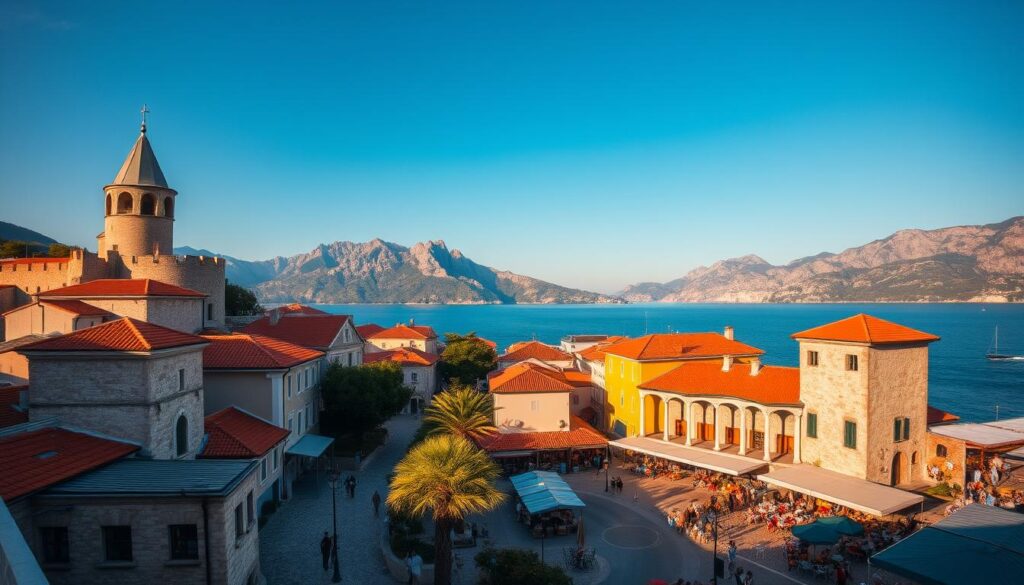
Beaches and Nightlife
Budva is famous for its beautiful beaches like Slovenska Plaža and Jaz Beach. They’re great for relaxing and trying water sports. At night, the town comes alive with bars, clubs, and beach parties for everyone.
Some of the popular beaches in Budva include:
| Beach Name | Location | Features |
|---|---|---|
| Slovenska Plaža | Central Budva | Sandy beach, water sports, cafes |
| Jaz Beach | Near Budva Old Town | Pebbly beach, beach bars, lively atmosphere |
| Povile Beach | A short drive from Budva | Secluded, pebbly beach, clear waters |
Sveti Stefan Island
Sveti Stefan Island is a beautiful spot off Budva’s coast. It’s known for its beaches, clear waters, and luxury resorts. You can visit for the day or stay in one of its fancy hotels.
Budva and its area offer a mix of history, relaxation, and fun. It’s a top vacation spot in Montenegro.
Durmitor National Park: Montenegro’s Mountain Paradise
Durmitor National Park is a UNESCO World Heritage site. It’s known for its rugged mountains, glacial lakes, and lush forests. It’s perfect for nature lovers and adventure seekers.
Black Lake and Hiking Trails
The Black Lake is a top attraction in Durmitor. It offers calm surroundings and beautiful views. You can take a relaxing walk or try more challenging hiking trails.
The trails give you stunning views of mountains and valleys. Every step is a reward.
Tara River Canyon
The Tara River Canyon is a highlight of Durmitor. It has some of Europe’s deepest river gorges. You can go rafting or enjoy the views from the edge.
The canyon’s dramatic landscape shows the region’s natural beauty.
Winter Activities in Durmitor
In winter, Durmitor turns into a winter wonderland. It offers winter sports like skiing and snowboarding. You can also go on a snowshoeing tour.
Winter activities let you see the park’s beauty in a unique way.
| Activity | Location | Best Time |
|---|---|---|
| Hiking | Black Lake Trails | June to September |
| Rafting | Tara River Canyon | April to October |
| Skiing | Durmitor Ski Slopes | December to March |
Durmitor National Park is great for many interests and activities. It’s perfect for adventure or nature connection. As part of your Montenegro sightseeing guide, Durmitor is a must-see. It will give you memories to last a lifetime.
Perast: The Pearl of the Bay of Kotor
Perast is a treasure in Montenegro, known for its rich maritime history and stunning baroque architecture. Walking through its streets feels like stepping into a world of elegance and refinement.
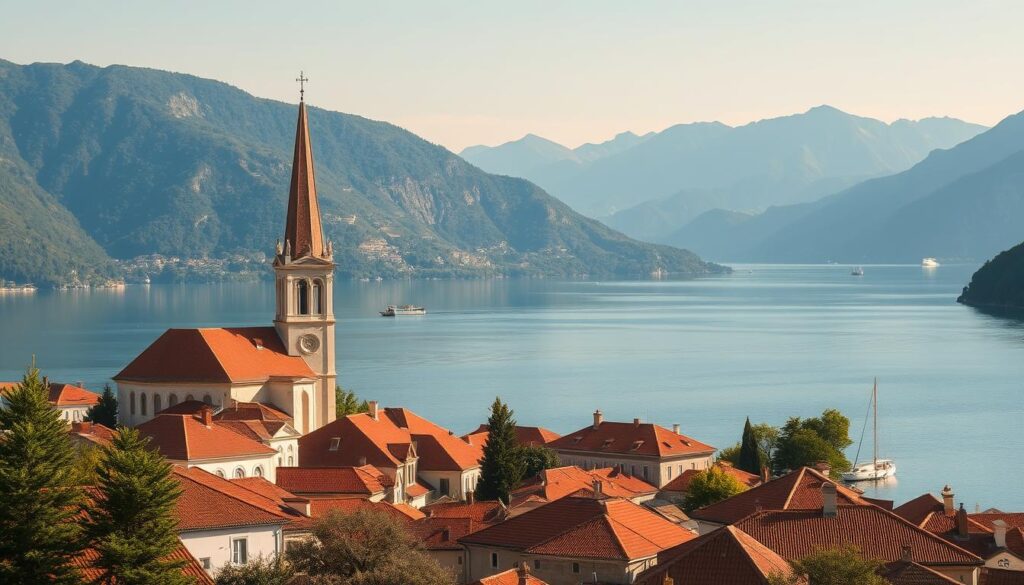
Our Lady of the Rocks Island
The Our Lady of the Rocks island is a key attraction in Perast. It’s a man-made island, created by sailors over the years. They threw rocks into the sea, building the island.
Visitors can take a boat to the island. There, they can see a beautiful church and museum. It’s a top spot to visit in Montenegro.
Baroque Architecture and Maritime History
Perast is famous for its beautiful baroque buildings. These grand palaces and churches show its past as a major maritime power. The maritime museum and historic buildings reveal the town’s history and design.
As a Montenegro travel destination, Perast offers a mix of culture and history. It’s a must-see on any trip.
Lake Skadar National Park: A Birdwatcher’s Paradise
Exploring Lake Skadar National Park reveals a world of natural wonders and wildlife. Located on the border with Albania, it’s a top spot for nature lovers and birdwatchers.
Boat Tours and Wildlife
Boat tours are a great way to see Lake Skadar’s beauty. These tours let you glide through the lake’s calm waters. You’ll get close to amazing wildlife, including over 270 bird species.
You might see pelicans, herons, and even the rare Dalmatian pelican. The tours also show you fish and plants native to the area. Guides share their knowledge, making your visit unforgettable.
Surrounding Villages and Wineries
The villages around the lake give a peek into traditional Montenegrin life. You can visit wineries and try the region’s fine wines. The locals are friendly, and you might enjoy a meal at a family-run restaurant.
Visiting these villages and wineries enriches your Lake Skadar experience. It’s a chance to taste local food and learn about the area’s history and customs.
Cetinje: The Historic Capital of Montenegro
Exploring Montenegro means you can’t miss Cetinje. This town was once the capital and is full of history. It shows the country’s royal past and religious traditions.
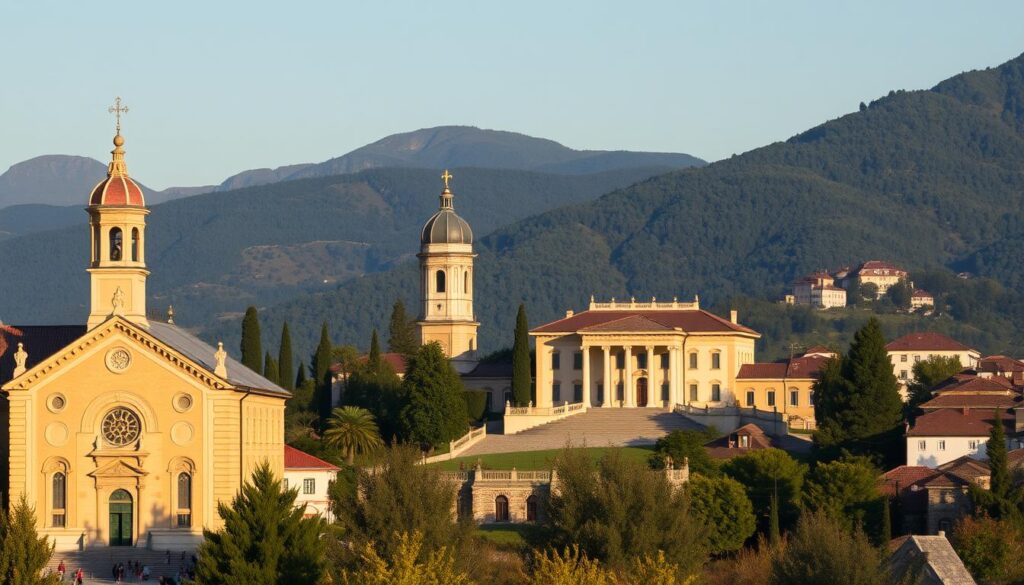
Royal Heritage and Museums
Cetinje is famous for its museums and historic sites. The National Museum of Montenegro is a key spot. It’s in the old royal palace and tells the story of Montenegro’s history, art, and culture.
The King’s Palace is another important place. It shows what life was like for the royal family. The palace’s architecture and gardens are stunning.
Monastery of Cetinje
The Monastery of Cetinje is a spiritual and cultural center. It has important religious items, like the Hand of St. John the Baptist. This monastery is key in Montenegro’s religious history.
Visiting the monastery lets you see its historical importance. The monastery’s treasury is also worth seeing. It has many religious relics and artifacts.
Going to Cetinje is a must for anyone wanting to learn about Montenegro’s history. It’s a key part of any montenegro sightseeing guide. As you explore montenegro landmarks, Cetinje shows the nation’s rich history and culture.
Ulcinj: Where East Meets West
Ulcinj is a standout in Montenegro, where East and West blend. This coastal town is rich in history. It offers a mix of cultures, landscapes, and experiences that make it a must-see place in Montenegro.
Long Beach and Ada Bojana
Ulcinj is famous for its Long Beach. It’s ideal for sunbathing, swimming, and water sports. Nearby, Ada Bojana island is a naturist’s paradise with a calm vibe.
Boat trips around the island are popular. They let visitors see the island’s beauty and wildlife.
Old Town and Cultural Heritage
The Old Town of Ulcinj is a labyrinth of narrow streets and ancient buildings. Its architecture shows Mediterranean and Ottoman styles. Visitors can see the old town walls, the Balšić Tower, and enjoy the town’s lively cultural scene.
Ulcinj’s food is a blend of Montenegrin and Mediterranean tastes. You can try local seafood and traditional dishes. The locals’ warm welcome makes Ulcinj a memorable Montenegro travel destination.
Ostrog Monastery: Montenegro’s Spiritual Wonder
The Ostrog Monastery is a stunning sight, perched on a cliff. It shows the spiritual side of Montenegro. This significant spiritual site is a symbol of faith and architecture, drawing visitors from all over.
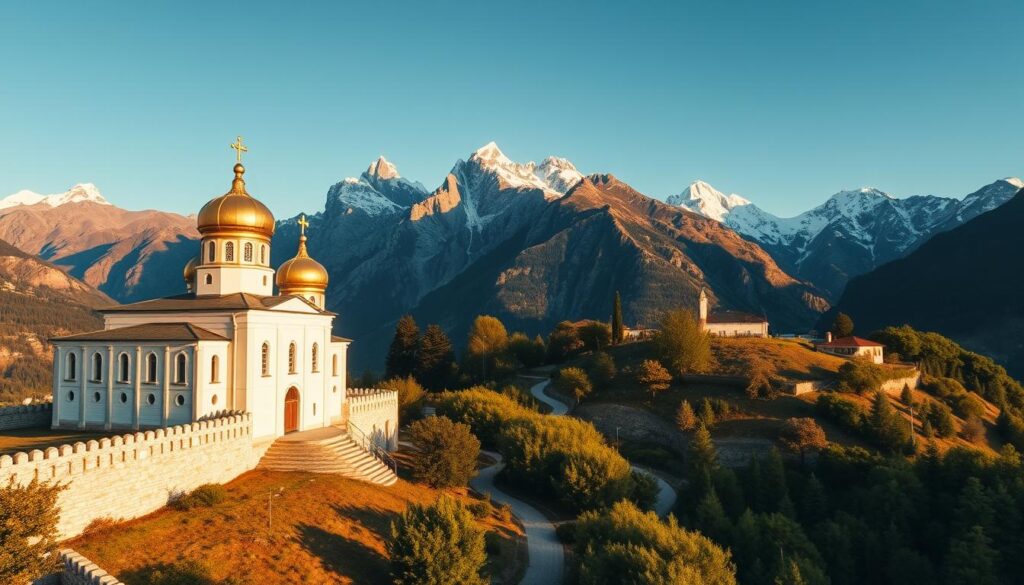
The Miraculous History
Ostrog Monastery was built in the 17th century. It stands as a symbol of Orthodox Christianity in Montenegro. Its history is filled with miracles, showing the power of faith.
The monastery has two parts: the Lower and Upper Monasteries. The Upper Monastery is famous for being built into the cliff. Climbing up is tough but offers amazing views and a spiritual reward.
| Aspect | Lower Monastery | Upper Monastery |
|---|---|---|
| Accessibility | Easy, suitable for all visitors | Challenging climb required |
| Spiritual Significance | Important religious ceremonies | Site of miraculous icons and relics |
| Scenic Views | Surrounding landscape | Breathtaking cliff face views |
Visiting Tips and Etiquette
Visiting Ostrog Monastery requires respect for its spiritual value. Dress modestly, covering your shoulders and knees. Photography is allowed, but not during ceremonies.
Here are some tips for your visit:
- Go early to avoid crowds.
- Bring water and snacks, for the Upper Monastery.
- Respect the religious practices and traditions.
Exploring Ostrog Monastery is more than seeing a top tourism attraction. It’s diving into Montenegro’s spiritual heritage. Whether you’re interested in faith, history, or nature, Ostrog Monastery offers a deep and enriching experience.
Top 10 Places to Visit in Montenegro – Travel Guide: Planning Your Itinerary
Montenegro is a hidden gem on the Adriatic coast. It offers history, nature, and relaxation. Planning your trip carefully is key to enjoying your time here.
Whether you want to see medieval towns, beautiful beaches, or mountains, a good plan is essential. This way, you’ll make the most of your visit.
How Many Days Are Enough for Montenegro?
The perfect trip length in Montenegro varies. For a quick taste, 3 days can show you Kotor’s bay or Budva’s beaches. But, for a full experience, 7 to 10 days is better.
With more time, you can explore more. Visit lesser-known spots and enjoy nature slowly. For example, hike in Durmitor National Park or take a Lake Skadar boat tour.
Sample Itineraries (3, 7, and 10 Days)
Here are some itineraries to help plan your trip:
- 3-Day Itinerary:
- Day 1: Explore Kotor’s Old Town and bay.
- Day 2: Visit Budva’s Stari Grad and enjoy the beaches.
- Day 3: Hike in Lovćen National Park or visit Cetinje.
- 7-Day Itinerary:
- Day 1-2: Kotor and surrounding areas.
- Day 3: Budva and Sveti Stefan.
- Day 4: Day trip to Perast and Our Lady of the Rocks.
- Day 5: Explore Durmitor National Park.
- Day 6-7: Visit Lake Skadar and enjoy local cuisine.
- 10-Day Itinerary:
- Day 1-2: Kotor and its bay.
- Day 3-4: Budva and Ulcinj.
- Day 5: Visit Ostrog Monastery.
- Day 6-7: Enjoy hiking and outdoor activities in Durmitor.
- Day 8: Explore Cetinje and its museums.
- Day 9-10: Relax at Lake Skadar or visit nearby wineries.
These itineraries can be tailored to your interests and the season. For example, winter is great for skiing in Durmitor or enjoying Kotor’s festive vibe.
By following these plans, you’ll see the best of Montenegro. From stunning landscapes to rich culture, you won’t miss out.
Where to Stay in Montenegro: Best Regions for Travelers
Choosing the right place to stay in Montenegro can make your trip better. The country has different landscapes, rich history, and lively culture. It offers many places to stay, fitting every traveler’s needs.
Coastal Areas: Budva, Kotor, and Herceg Novi
The coastal areas of Montenegro are very popular. Budva is known for its fun nightlife and beautiful beaches. Kotor has a medieval old town and a stunning bay. Herceg Novi is near the Bay of Kotor, offering beaches and culture.
In these coastal spots, you’re close to the action. Budva’s old town has narrow streets and historic buildings. Kotor’s bay is great for sailing. Herceg Novi’s beaches are more laid-back.
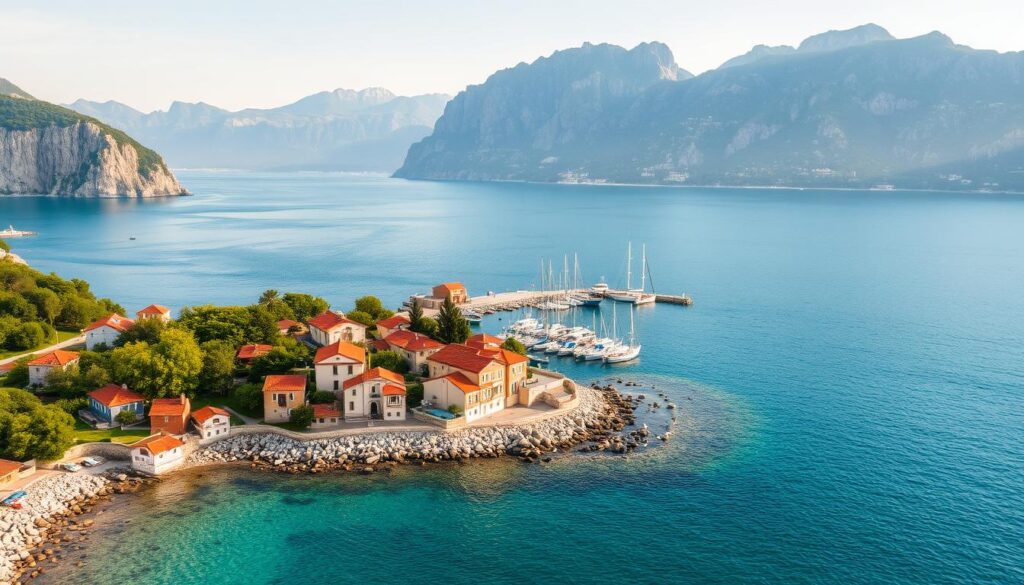
Inland Destinations: Cetinje and Durmitor
For natural beauty, visit the inland areas. Cetinje is the historic capital with royal heritage and museums. Durmitor National Park has amazing mountains for hiking and skiing.
Cetinje shows Montenegro’s royal past through its buildings and museums. Durmitor is a nature lover’s dream, with lakes, mountains, and forests.
| Region | Main Attractions | Best For |
|---|---|---|
| Budva | Beaches, Nightlife, Old Town | Partygoers, Families |
| Kotor | Medieval Old Town, Bay of Kotor | History Buffs, Nature Lovers |
| Herceg Novi | Beaches, Cultural Heritage | Families, Couples |
| Cetinje | Royal Heritage, Museums | History Enthusiasts |
| Durmitor | National Park, Outdoor Activities | Nature Lovers, Adventure Seekers |
The Most Beautiful Parts of Montenegro for Accommodation
Montenegro has many beautiful places to stay. You can choose from lively coastal towns or peaceful mountains. There’s a perfect spot for everyone.
Stay in places that mix culture, history, and nature. The Bay of Kotor is stunning and close to historic towns. Durmitor’s mountains offer outdoor fun and beautiful views.
Choosing the right region makes your Montenegro trip unforgettable. You’ll create amazing memories.
Practical Travel Tips for Montenegro
To enjoy your trip to Montenegro, knowing some travel tips is key. This beautiful Adriatic coast country has amazing natural views, a rich history, and lively culture. Knowing how to travel around will make your trip better.
Getting Around Montenegro
Montenegro has a good transport system with buses, taxis, and cars for rent. Driving is the best way to see the country. It lets you explore off-the-beaten-path places and enjoy the views.
- Rental cars are available at major airports and cities.
- Public buses connect major towns and tourist spots.
- Taxis are common, but always agree on the fare first.
For a relaxed trip, try a boat tour in the Bay of Kotor. It offers a special view of the coastline.
Currency and Costs
The Euro (€) is Montenegro’s official currency, making it easy for Europeans. Credit cards are accepted in many places. But, it’s wise to carry some cash for small buys or local markets.
| Expense | Average Cost (€) |
|---|---|
| Meal at a mid-range restaurant | 10-15 |
| Public bus ticket | 1-2 |
| Accommodation in a budget hotel | 30-50 per night |
Language and Communication
Montenegrin is the official language, but many speak English, mainly in service jobs. You can usually get by without Montenegrin. But, learning basic phrases will help you connect with locals.
“Language is the blood of the people, and the key to understanding their culture.”
Mobile phones work well in most places, and many places offer free Wi-Fi. If you’re staying long or need internet, think about getting a local SIM card.
Knowing these practical tips will help you enjoy Montenegro’s stunning landscapes and rich culture.
Conclusion: Why Montenegro Is the Perfect Home Base for Exploring Europe
Montenegro is a mix of culture, history, and natural beauty. It’s a great place for travelers. With its beautiful Adriatic coastline, medieval towns, and mountains, it’s full of travel spots and attractions.
Being a travel hub, Montenegro is easy to get around Europe from. You can see historic cities like Dubrovnik, visit Italy’s villages, or explore Eastern Europe’s cities. Its small size and good airports make it perfect for your European trip.
Montenegro has something for everyone. You can relax on beaches, hike in national parks, or dive into its culture. With its friendly people, tasty food, and varied landscapes, it’s a great place to make lasting memories. Think of Montenegro as your base for exploring Europe’s best spots.
FAQ
What is the best time to visit Montenegro?
The shoulder seasons, April-May and September-October, are the best times to visit Montenegro. The weather is nice, and there are fewer people around. For beach fun, June to August is the peak time. If you love winter sports, November to March is the best.
How many days are enough to explore Montenegro?
To see Montenegro well, 7-10 days is a good start. This time lets you visit places like Kotor, Budva, and Durmitor National Park.
What are the must-see places in Montenegro?
Don’t miss Kotor’s old town, Budva’s beaches, and Durmitor National Park’s trails. Lake Skadar is great for birdwatching.
What is the best way to get around Montenegro?
Driving is the best way to see Montenegro’s beauty. You can also use public transport, taxis, or rent a bike.
What is the currency used in Montenegro?
Montenegro uses the Euro, even though it’s not in the Eurozone. You can exchange money at airports, banks, or currency offices.
Do I need a visa to visit Montenegro?
Visa rules for Montenegro depend on your country. Check with your local embassy or consulate to see if you need one.
What language is spoken in Montenegro?
Montenegrin is the official language, but English is common in tourist spots. You can also use apps or guides for help.
Can I use credit cards in Montenegro?
Yes, you can use Visa, Mastercard, and American Express in Montenegro, mostly in tourist areas and big towns.
What are the best regions to stay in Montenegro?
Coastal spots like Budva and Kotor are great for beach lovers and history buffs. Inland areas like Cetinje and Durmitor are perfect for culture and outdoor fun.
Is Montenegro a good destination for families?
Yes, Montenegro is excellent for families. It has beautiful beaches, outdoor fun, and cultural spots. Many places and tours are family-friendly.
- Koundinya Wildlife Sanctuary Travel Guide 2026: Timings, Safari, Map, Reviews & Wildlife Highlights
- Kaas Plateau Travel Guide 2026: Best Time to Visit, Bloom Season, How to Reach & FAQs
- What Is the Quirimbas Archipelago Mozambique Known For? Complete Travel & Nature Guide
- Is Angola Safe to Travel in 2025? Your Essential Guide to Health, Crime, and Landmine Safety
- What Animals Live in Bale Mountains Ethiopia? Complete Wildlife Guide
Lake Baikal: https://xploreheaven.com/lake-baikal-the-pearl-of-siberia/

